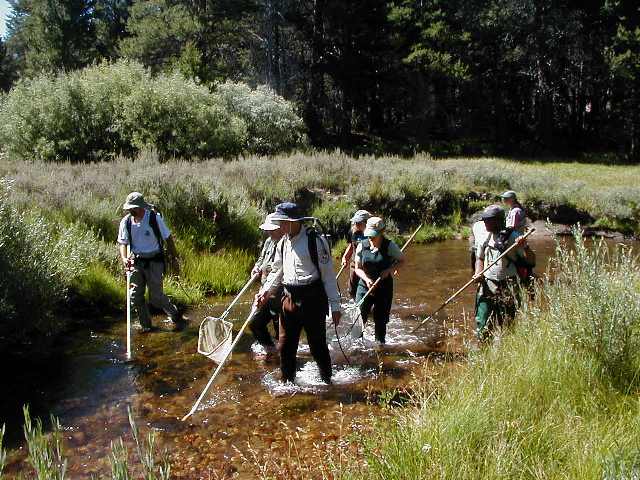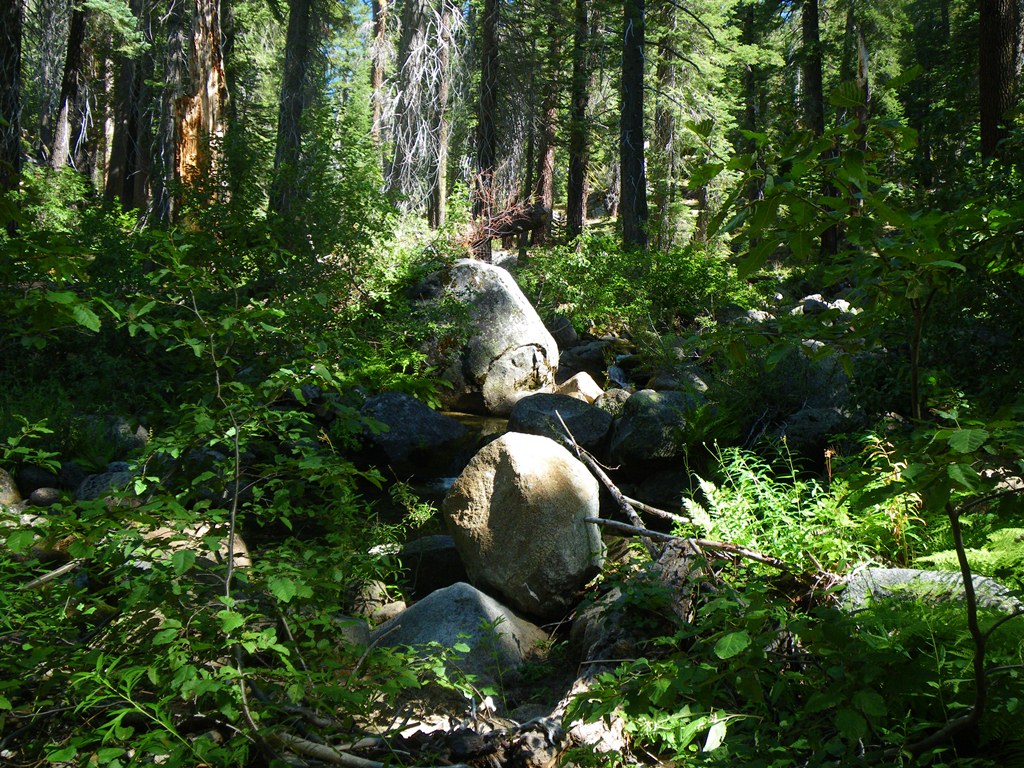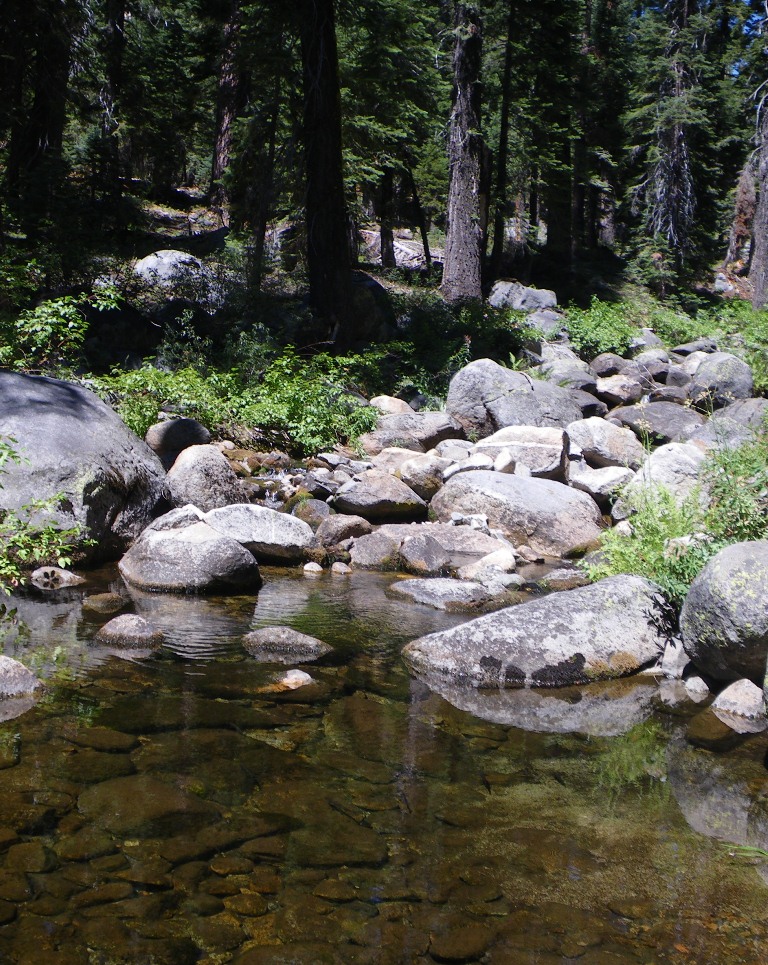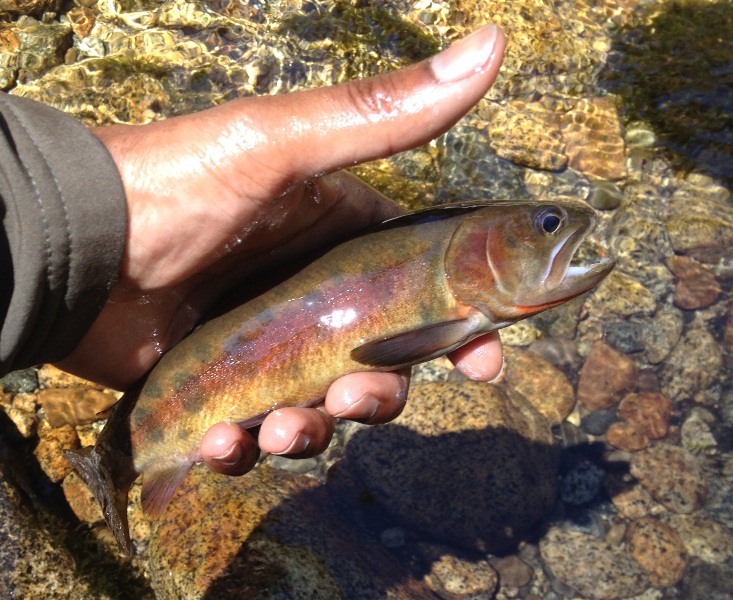|
|
|
|
|
August 21, 2012- A Paiute Stream Time: 6:30am to 6:30pm Narrative: For me, the Paiute Cutthroat Trout was unfinished business. The one truly different trout species in CA. that I had not been successful fishing. I'd tried a couple of times in the past - notably a trip to perform Paiute Trout restoration with Trout Unlimited and a trip to this same stream 6 years ago. I don't think I've ever written much about it but the TU trip was/is part of an ongoing process to restore the Paiute to its native habitat below Llewellyn falls on Silver King Creek. A group of TU volunteers and some folks from Fish and Game hiked 7 miles into Silver King Creek in order to prepare the stream for rotenone poisoning. Rotenone, as you may know, is a controversial method used to remove non-native fish from a water shed. It was famously used on Pike in Davis lake in the late 1990's and is planned for Silver King Creek. I say "is planned" because several environmental groups have postponed the actual poisoning of the stream several times since our visit.
We electro shocked 3 miles of stream and removed ~350 non- native trout. During our downtime we were able to fish below the Falls. Between my own fishing and the electro shocking, I didn't see a single Paiute. 6 years ago I made the same trek into the wilderness that I write about in this Chronicle. I hiked 3 hours in to find a dry creek bed. I continued down the trail and found another creek bed, not exactly dry but not full enough to hold fish. I knew that to find fish I'd have to work my way downstream but having already committed to a 12 mile round trip hike, I didn't have the confidence to bushwhack downstream, catch fish and make my way back to the car before dark. Now 6 years later and much fitter, I was ready to make that trek. Ready to commit to 15 plus miles in a single day with time inbetween to fish. I knew where I wanted to go and was fortunate enough to find someone that had been there to confirm my suspicions. Several years ago we made contact, me providing beta on my trip and where I think I should have gone to find fish. This year our rolls were reversed. I was able to confirm my suspicions with actual GPS coordinates. Thanks Gary. My target was the confluence of 3 forks of the stream. This would require a 2 - 3 mile off trail hike. I programmed two routes into my rarely used GPS- a longer route route which would essentially take me down a granite ramp to the stream and a shorter route which would have me trekking down the trail a bit longer, before trekking the last mile off trail to the stream. The GPS location that I got from Gary almost matched the location of my final destination so I knew I was good to go. The decision of which route to follow was made the night before. I plugged my coordinates into Google Maps and using the satellite view compared the two routes. The shorter off trail route was much more wooded that the longer off trail route. Off trail being the key here. The longer route was actually more direct but as most folks know, staying on a maintained trail is faster than making your own. That said, the longer trail was mostly over granite with little brush to deal with, so I chose that route and I'm glad I did. Once off the granite I found it very slow going, the brush was so dense that the shorter route would have probably taken me longer because of it. (I'm guessing in all that brush I would have been lucky to make 1 mile's headway in 1 hour.)
This trip turned out to be 17 miles round trip, the most I've done as a day trip. Some say the trek out of Tehipite is 18 miles and if that's the case, then that's the most I've done in a single day but the Tehipite trek was part of an extended trip with no fishing involved on the day. It was simply break camp and hike until you hit the trailhead. Of course the first mile or so included a 3,000 foot accent but still, no fishing is no fishing. This was different and so, like an Everest climber I set some milestones for myself. The first, regardless of where I was, I would start fishing at 11am and the second and most important, I would head back to the car at 2pm. That would give me 5.5 hours to climb out of the canyon before dark. I stayed high on the granite so that I could pick my routes down. This worked well until I reached the end of the giant slab. I had two choices, go right, an apparently easier, more gradual route or go left, which from my view point, might end in a drop off but would be faster. I was a bit impatient here. I had made good trail time but not so good off trail time. Staying high and picking my routes slowed down me a bit. It was a good choice but I was getting a bit impatient to get on the water. I went left. I'm glad I did. I had to make my way down a small bluff. A little sketchy but the brush at the base of the bluff was so dense that I have to imagine that the more gradual route would have been difficult and frustrating. I found trout almost immediately but I wasn't yet at my target destination: the confluence. It was 10:30am and there was probably another half mile to trek. By 11:00 am I'm guessing I was less than 100 yards from the confluence but that 100 yards probably would have taken another 15 min. to travel and I'd hit my first Everest milestone. It was time to fish.
I fished my 7ft 3wt which seems to excel on Lahontan and Paiute Trout streams. Almost immediately I started spooking fish. I was still in high country lake fishing mode from my recent backpacking trip to the headwaters of Bear Creek and not in small stream fishing mode. Immediately I spooked fish in the most unlikely holding areas, it was time to put my game face on. I had 4 hours to fish. I wanted to catch one Paiute and there is never any guarantee of that. It's was the kind of stream where you had to fish all the water. I was reminded that when I spooked a 10 plus inches fish from a toilet bowl sized pocket. Given the numerous plunge pools I'd seen, it was not the kind of place I expected a monster fish (for this stream) to be. That lesson learned, the water downstream was only accessible from upstream so I fished downstream a few feet before turning and fishing up. Downstream fish was tough. It was close quarters fishing and the fish were spooky. Fortunately, my 3wt rod will cast just the leader with very little movement or with a bow and arrow cast. It took some creative fly placement and casting to get the proper drift within all the brush but I managed to nearly hook my first fish. The pinpoint of the hook pricked the fish but the hook set was not solid. This happened to a couple of fish. On one, I blindly cast side arm to the side of a rock. I was facing downstream, the current split, part of it was travelling under my feet but the majority was travelling to my left around a rock. I'd already spooked any fish directly in front of me but I was blind to any fish on the other side of the rock and they to me. I made a side arm cast low and under a branch. I couldn't really see what the fly was doing when it landed. I figured I'd either hook a fish or get hung up. In my minds eye I imagined the fly travelling under the branch and to the edge of the rock when suddenly I saw ripples in the water. It was like dropping a stone in a still pond. I set the hook but again the fish got off. Heading upstream I did better on the hook sets and soon discovered that many of the larger fish were lounging under rocks in the tail outs. It didn't matter if it was the tail of a large plunge pool, small run or toilet sized pocket. In most cases the bigger fish were in the tails, even in the super shallow runs were one wouldn't expect fish. I mostly found that there were fish everywhere. One just had to look.
Heading upstream I quickly caught and landed a fish and then another and then another. It wasn't easy fishing to be sure. Drifts had to be good and profiles and motion minded but if you didn't spook a fish on approach, didn't spook the fish upon delivery of the fly and didn't put it off during the drift, you were likely to see the fish tilt its fins, point it's nose towards your fly and flare it's gills. Fish on! When I was extra lucky, a fish would actually turn and chase the fly before it drifted out of view. Other fish, usually larger, wanted the fly planted on its nose or drifted directly in its prime feeding lane before moving off station to feed. Only the tiny, 4 inches or smaller, fish hit the fly in that out of control manner that small fish do. The last hour of fish was spent casting only too larger fish. Those I thought were 8 inches or greater and there were plenty of those. I suspect that had I reached the confluence, a 12 inch Paiute would have been possible and if 12 inches was possible, goodness knows how large the fish may actually get here. Its food for thought and whets the desire for a second trip (as does the fact that I lost my hand made Amboyna net here.)
At 2:00pm I stopped fishing. Point of no return reached, it was time to trek back to the car. I bushwhacked my way through the brush to the granite and managed to find a better way up than I had down. Once on the giant slab I avoided as much elevation gain as possible until I finally had to make a last steep accent and then, with GPS in hand, found the spot where I turned off trail and headed back to the car. It was a 9 hour hike in all with 4 hours of fishing. Not a bad ratio given the experience.
Previous Yosemite / Ansel Adams Wilderness Chronicle Next Yosemite / Ansel Adams Wilderness Chronicle
|






